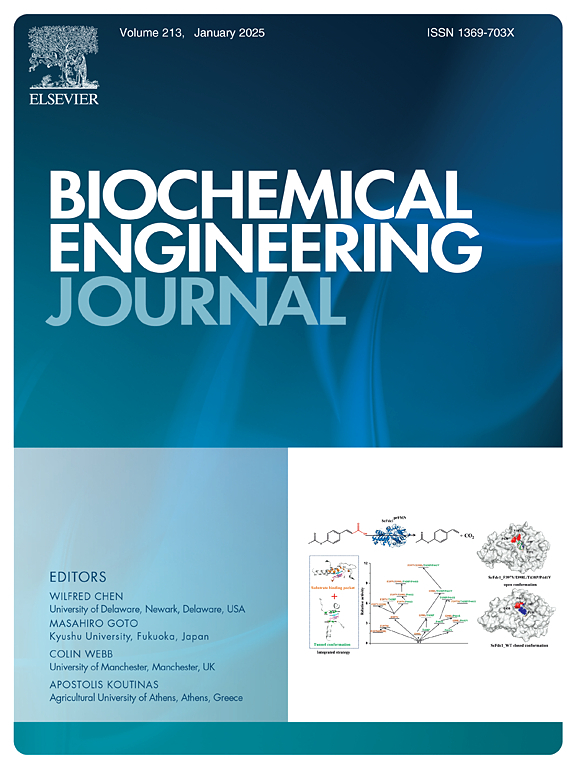Power production characteristics of binary particles pulsed anaerobic fluidized bed microbial fuel cell
IF 3.7
3区 生物学
Q2 BIOTECHNOLOGY & APPLIED MICROBIOLOGY
引用次数: 0
Abstract
A novel binary particulate pulsating anaerobic fluidized bed microbial fuel cell (BPFB-MFC) was designed and constructed in order to improve the efficiency of low-grade energy conversion in sewage. The effects of pulsed liquid flow rate and bed filling rate on the electricity production performance and effluent treatment characteristics of the BPFB-MFC were investigated experimentally. The results showed that when the pulsed liquid flow was u=1.95sin(π/3)t cm·s−1 and when the bed materials in the anode chamber consisted of 10 % bed height activated carbon particles and 10 % bed height ceramic particles, the highest voltage produced was 519.7 mV, the highest power density was 587.5 mW·m−2, and the lowest internal resistance was 171.2Ω, which was the optimal experimental working condition. It was found that the electricity production performance and effluent treatment efficiency of the mixed particles system were better than those of a system with single particles. This work held promise of promoting the industrialization of MFC.
二元颗粒脉冲厌氧流化床微生物燃料电池的发电特性
为了提高污水中低品位能量的转化效率,设计并构建了一种新型二元颗粒脉动厌氧流化床微生物燃料电池(BPFB-MFC)。实验研究了脉冲液体流速和床层填充率对 BPFB-MFC 发电性能和污水处理特性的影响。结果表明,当脉冲液流为 u=1.95sin(π/3)t cm-s-1,阳极室的床层材料由 10 % 的床层高度活性炭颗粒和 10 % 的床层高度陶瓷颗粒组成时,产生的最高电压为 519.7 mV,最高功率密度为 587.5 mW-m-2,最低内阻为 171.2Ω,这是最佳的实验工作条件。实验发现,混合颗粒系统的发电性能和污水处理效率均优于单一颗粒系统。这项工作有望促进 MFC 的产业化。
本文章由计算机程序翻译,如有差异,请以英文原文为准。
求助全文
约1分钟内获得全文
求助全文
来源期刊

Biochemical Engineering Journal
工程技术-工程:化工
CiteScore
7.10
自引率
5.10%
发文量
380
审稿时长
34 days
期刊介绍:
The Biochemical Engineering Journal aims to promote progress in the crucial chemical engineering aspects of the development of biological processes associated with everything from raw materials preparation to product recovery relevant to industries as diverse as medical/healthcare, industrial biotechnology, and environmental biotechnology.
The Journal welcomes full length original research papers, short communications, and review papers* in the following research fields:
Biocatalysis (enzyme or microbial) and biotransformations, including immobilized biocatalyst preparation and kinetics
Biosensors and Biodevices including biofabrication and novel fuel cell development
Bioseparations including scale-up and protein refolding/renaturation
Environmental Bioengineering including bioconversion, bioremediation, and microbial fuel cells
Bioreactor Systems including characterization, optimization and scale-up
Bioresources and Biorefinery Engineering including biomass conversion, biofuels, bioenergy, and optimization
Industrial Biotechnology including specialty chemicals, platform chemicals and neutraceuticals
Biomaterials and Tissue Engineering including bioartificial organs, cell encapsulation, and controlled release
Cell Culture Engineering (plant, animal or insect cells) including viral vectors, monoclonal antibodies, recombinant proteins, vaccines, and secondary metabolites
Cell Therapies and Stem Cells including pluripotent, mesenchymal and hematopoietic stem cells; immunotherapies; tissue-specific differentiation; and cryopreservation
Metabolic Engineering, Systems and Synthetic Biology including OMICS, bioinformatics, in silico biology, and metabolic flux analysis
Protein Engineering including enzyme engineering and directed evolution.
 求助内容:
求助内容: 应助结果提醒方式:
应助结果提醒方式:


